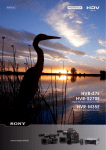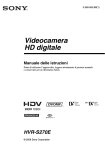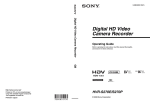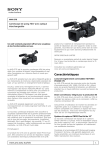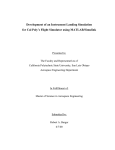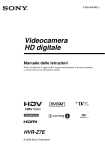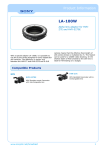Download Product Preview HVR-Z7E HDV handheld camcorder & HVR
Transcript
Product Preview HVR-Z7E HDV handheld camcorder & HVR-S270E HDV shoulder-mount camcorder www.sonybiz.net/hdv 13th November 2007 Contents Introduction ................................................................................................................. 3 Models and Availability ............................................................................................... 3 Target Markets & Applications .................................................................................... 3 Product Positioning ..................................................................................................... 4 USPs and Key Selling Points...................................................................................... 4 Key Features .............................................................................................................. 4 1. New Lineup Expanding the HDV Format World ............................................... 4 a. Switchable Recording and Playback- HDV1080i/DVCAM/DV.......................... 5 2. Built-in Down-converter for SD Production....................................................... 5 3. Cutting-edge Imaging System for New Camcorders ........................................ 5 a. 1/3-inch type 3 ClearVid CMOS Sensor System .............................................. 5 b. Enhanced Functionality via the Technology of “Exmor” ................................... 6 4. Interchangeable Lens System Offers Unlimited Possibilities ........................... 7 a. Carl Zeiss Lens for HD Video as Standard ...................................................... 7 b. Easy-to-use Interchangeable Lens for Fixed-lens Camcorder Users ............... 7 5. Natural-touch Lens Operation .......................................................................... 8 a. Focus ............................................................................................................... 8 b. Zoom................................................................................................................ 8 c. Iris .................................................................................................................... 8 6. Wide Range of Lenses..................................................................................... 8 a. α Lens Compatibility......................................................................................... 9 7. Operational Versatility ...................................................................................... 9 a. Manual Camera Settings.................................................................................. 9 b. Shooting Support Functions........................................................................... 10 8. Selectable Progressive Modes....................................................................... 11 a. 25p HDV Native Progressive Recording Modes............................................. 12 b. 25p Progressive Scan Modes ........................................................................ 12 9. Other Features of the HVR-Z7E and HVR-S270E ......................................... 13 a. New Supplied Monaural Microphone ECM-XM1 ............................................ 13 b. 50i/60i Switchable Option............................................................................... 13 Price ......................................................................................................................... 14 Promotion ................................................................................................................. 14 Competition..................................................................Error! Bookmark not defined. www.sonybiz.net/hdv 13th November 2007 Introduction Sony is proud to introduce two new HDV™ camcorders that deliver the enhanced functionality professionals have been waiting for: an interchangeable lens system, native progressive recording, and solid-state memory recording. Introducing the HVR-Z7E, the world’s first HDV handheld camcorder that uses 1/3-inch bayonet joint interchangeable lenses, and the HVR-S270E shouldermount camcorder, which supports standard-size cassettes for extended recording times. A streamlined nonlinear editing workflow can be achieved using the supplied HVRMRC1 memory-recording unit, which provides HDV/DVCAM/DV file recording on a standard CompactFlash® solid-state memory card. This offers customers varying levels of flexibility and hybrid operation which is becoming an important requirement in video production. These groundbreaking new camcorders feature 25p HDV native progressive recording modes and they also have HDMI or HD/SD-SDI output. This next-generation range features the HVR-M35E Video Cassette Recorder, which has HD/SD-SDI output. Models and Availability Model HVR-Z7E HVR-S270E HVR-M35E Description HDV handheld camcorder Shoulder-mount camcorder Video Cassette Recorder Availability Feb 2008 Feb 2008 Feb 2008 Target Markets & Applications • • • • • • Entry Level Broadcast Corporate Production Budget Movie Makers Web Content Creators Education Wedding / Event Videographers www.sonybiz.net/hdv 13th November 2007 • • Natural History film-makers Music Videos Product Positioning These new Camcorder solutions enhance the operational versatility of the Sony professional HDV lineup, and open up a world of possibilities for high-definition digital video production. Whether it’s for documentaries, mainstream news, low-budget movies, music videos, Internet, education, or a wide range of industrial applications, Sony’s new HDV camcorders are ideal. USPs and Key Selling Points Interchangeable Lens System, Native Progressive Recording, and Solid-state Memory Recording – Sony’s Commitment to the HDV World Brings a Remarkable Evolution in Next-generation Products. • • • Interchangeable Lens System Native Progressive Recording Solid-state Memory Recording Key Features 1. New Lineup Expanding the HDV Format World Sony’s commitment to HDV has resulted in the remarkable evolution of cutting-edge technology equipment, such as the HVR-Z7E and HVR-S270E, which use the popular HDV1080i recording format. The HDV1080i format uses one of the “MPEG2 Long GOP” compression profiles. This highly efficient and robust codec – which is also used in the Sony XDCAM HD and XDCAM EX series – enables users to record stunning-quality HD video. The HVR-Z7E provides over 60 minutes*1 of recording time using the widely available miniDV videotape. While the HVR-S270E has the additional option of using standard-size cassettes that provide over 4.5 hours*2 of continuous recording. *1 Approximate recording time of 63 minutes when using Sony PHDVM-63DM. *2 Approximate recording time of 276 minutes (4 hours 36 minutes) when using Sony PHDV-276DM. Native editing in the HDV format is now supported by most popular NLE (Nonlinear editing) software. www.sonybiz.net/hdv 13th November 2007 Additionally, HDV signals can be recorded as a file on non-tape media. For example, when using the supplied HVR-MRC1 – a CompactFlash (CF) solid-state memory recording unit – images can be stored on a standard CF card for quick nonlinear editing. The optional HVR-DR60 Hard Disk Recording Unit can be used in the same manner, with images being recorded on to its large-capacity 60GB hard drive, which provides 4.5 hours of recording time. a. Switchable Recording and Playback- HDV1080i/DVCAM/DV The HVR-Z7E and HVR-S270E can switch between HDV1080i, DVCAM, and DV recording, providing full flexibility to record in either standard definition or high definition depending on your production needs. 2. Built-in Down-converter for SD Production The HVR-Z7E and S270E can convert material from 1080i down to 576i, and output the video signals through its i.LINK interface and other SD output connectors. This allows users to edit recorded material with a compatible nonlinear editing system using current DV editing software, as well as record SD signals to an external VTR. 3. Cutting-edge Imaging System for New Camcorders a. 1/3-inch type 3 ClearVid CMOS Sensor System The newly developed 1/3-inch type 3 ClearVid CMOS Sensor™ system has 45degree rotated pixels on each chip in order to increase the signal density, while each pixel maintains sufficient surface area. In combination with Enhanced Imaging Processor™ (EIP), the 3 ClearVid CMOS Sensor system achieves high resolution, high sensitivity, wide dynamic range, and excellent colour reproduction. The pixel shift interpolation technique has been traditionally used in low-end 3CCD camcorders. However, it normally requires the combination of all three colour element (RGB) signals to maximize resolution. If an object lacks one or more colour elements, the resolution of the object may be degraded. The 3 ClearVid CMOS Sensor system is different. It can always produce maximum resolution, regardless of the balance between colour elements, thanks to its unique and sophisticated interpolation technology. www.sonybiz.net/hdv 13th November 2007 b. Enhanced Functionality via the Technology of “Exmor” Both the HVR-Z7E and HVR-S270E offer cutting-edge features, such as the technology of “Exmor™” developed by Sony, which utilizes the full potential of the 3 ClearVid CMOS Sensor system. The technology of “Exmor”, which features the column-parallel A/D conversion technique, is also used in the PMW-EX1 XDCAM EX camcorder. Multiple A/D (analog to digital) converters on each pixel row convert analog signals to digital as soon as they are generated, unlike traditional technology that only has one A/D converter on each chip. The technology of “Exmor” can eliminate the influence of external noise that enters the signal chain during transfer to the A/D converter, resulting in high-quality digital signals with extremely low noise. This significantly enhances shooting in low-light environments. By adopting this groundbreaking technology, the new 1/3-inch 3 ClearVid CMOS Sensor system enables the HVR-Z7E and HVR-S270E to achieve a low light sensitivity of just 1.5 lux.* *At 1/30 shutter, auto iris and auto gain This will be of extreme importance to customers who shoot in lighting conditions that they can’t control, e.g. wedding videographers. www.sonybiz.net/hdv 13th November 2007 4. Interchangeable Lens System Offers Unlimited Possibilities Various video lenses can be attached to the HVR-S270E and HVR-Z7E, which are both equipped with a universal standard 1/3-inch bayonet mount mechanism for quick changing of lenses. a. Carl Zeiss Lens for HD Video as Standard A high-quality, multi-purpose Carl Zeiss lens for HD video comes as standard with the HVR-S270E and HVR-Z7E. Stunning resolution and contrast is achieved thanks to the Carl Zeiss Vario-Sonnar™ T* coating, which suppresses unwanted reflections. A specially designed wide-angle lens is also available as an option, to suit a diverse range of shooting requirements. Optical Zoom Lens Standard lens (supplied) Wide lens (option) VCL-412BWH (for HVR-Z7E) VCL-412BWS (for HVR-S270) VCL-308WBH (for HVR-Z7E) VCL-308BWS (for HVR-S270E) 12x 8x Focal Length*3 F number 32mm-384mm (16:9) 1.6 – 4.0 24mm-192mm (16:9) 1.6 – 2.8 *3 These values are calculated to be equivalent to 35 mm film. b. Easy-to-use Interchangeable Lens for Fixed-lens Camcorder Users These lenses give Sony’s two new HDV camcorders the same functionality as popular fixed-lens camcorders like the HVR-Z1E and HVR-V1E, thanks to built-in features such as auto-focus, optical stabilizer, and automatic back-focus adjustment. Current users of the above camcorders will easily become adept at using the HVRZ7E and HVR-S270E, even if they have never used interchangeable lenses. www.sonybiz.net/hdv 13th November 2007 5. Natural-touch Lens Operation a. Focus The newly designed focus ring offers two types of manual focus, plus an auto focus mode that can be easily switched by sliding the focus ring forward or backward. When the focus ring is in the front position, the lens works in the same way as the HVR-Z1E, HVR-V1E, and DSR-PD170P. In this case, either manual or auto focus mode can be selected by the assignable button on the lens. On the other hand, when the focus ring is set to the rear position, the focus ring has a physical stop at infinity and works in the same way as a professional interchangeable lens, with fixed-focus-position and distance indicators. b. Zoom Fast, intuitive manual-zoom response is provided by an internal gearwheel mechanism that provides accurate zoom positioning. A high-quality servo-motor provides the smooth zooming performance that industry professionals have come to rely on. c. Iris The iris ring encircles the lens barrel. Manual iris adjustment is possible with an ENGtype ring system that allows fine exposure control for challenging lighting situations. 6. Wide Range of Lenses The flexible bayonet lens attachment system allows you to use a wide range of lenses. Standard 1/3-inch HD video lenses, from manufacturers such as Fujinon and Canon, can be attached directly to the HVR-Z7E and HVR-S270E. If you’d like to attach a 2/3-inch or 1/2-inch HD video lens on the HVR-Z7E or HVRS270E, it is possible to do so by adding a standard lens adaptor from the lens manufacturer. The HVR-S270E and HVR-Z7E camcorders have 12-pin lens connectors allowing compatibility with professional ENG lenses. This feature is very useful not only for those who already have these professional HD video lenses, but also for those who prefer to use HD digital cinema lenses for their unique contrast, colour, and atmosphere. www.sonybiz.net/hdv 13th November 2007 a. α Lens Compatibility With a special adaptor from Sony, it is also possible to use the α lens series designed for Sony Digital SLR still cameras. By using α lenses in various configurations, creative effects can be achieved. This approach is ideal for filmmakers on a budget or those who already own α lenses. Note: The focal length is doubled with a 2/3-inch lens adaptor The focal length is increased 1.3 times with a 1/2-inch lens adaptor The focal length is increased 7 times with an α lens adaptor Some lenses may not be compatible and not all lens functions may be available 7. Operational Versatility a. Manual Camera Settings Three ND Filters The HVR-Z7E and HVR-S270E have three built-in ND (Neutral Density) filters, which help users to reduce light intensity under bright shooting conditions. Negative Gain A negative gain setting of -3 dB has also been added to help reduce sensitivity under bright lighting conditions. When the iris needs to be opened to create a short depth of field, a suitable brightness can be achieved with this function. Smooth Gain The Smooth Gain function is a smooth transition gain system that avoids sudden brightness changes caused by manual gain-level adjustment. With this function, the brightness changes gradually when the gain-level position is switched and avoids any sudden, unwanted iris adjustment. Smooth WB (White Balance) The Smooth WB feature is a smooth transition white balance system that avoids unnatural sudden colour temperature changes between preset white balance settings. For example, this function is useful when you move from an artificial, lowlight environment inside a building, to bright natural sunlight outside. www.sonybiz.net/hdv 13th November 2007 b. Shooting Support Functions Advanced Histogram The Histogram Indicator for brightness can be displayed on the LCD monitor and viewfinder, allowing operators to easily evaluate the brightness of captured images. A target window appears in the center of the screen and the brightness level is indicated by a vertical red line in the histogram. The zebra indicator level appears as a yellow vertical line in the histogram as reference for proper exposure. Focus Marking When the focus position needs to be manually moved to pre-decided positions, you can put up to two markers (A and B) on a focus position indicator in the LCD/EVF as reference points. When the focus position becomes aligned with one of these markers, it will begin to flash. This allows you to keep your eye on the subject of your shot, without having to check the focus indicator on the lens. Camera Leveling The HVR-Z7E and HVR-S270E both have a built-in three-dimensional gravity (3G) sensor, which detects the horizontal level of the camcorder and displays it via an indicator in the LCD/EVF. This digital leveler function makes it possible to obtain a horizontal level reading even when shooting without a tripod. AE Window Six types of AE (Auto Exposure) can be selected to automatically adjust the exposure to the most suitable level. Picture Profile Up to six different picture-quality settings, including gamma and colour settings, can be registered in the memory as picture profiles. This labour-saving function allows operators to easily recall customized picture-quality settings for various shooting conditions. It is also useful for matching footage shot at different times or for multicamera setups. The picture-profile functions of the HVR-Z7E and HVR-S270E include enhanced versions from the HVR-Z1E or HVR-V1E, plus a selection of new functions. Colour Depth Generally, the brightness of a video image increases as the colour level becomes more vivid. In these new camcorders, the brightness and colour level are processed independently so that more flexible tone – for instance, a dark image with a vivid colour – is realized by 3D-LUT*4 colour processing. www.sonybiz.net/hdv 13th November 2007 *4 Note: 3D-LUT = three-dimensional look-up table Colour Correction The Colour Correction function of the HVR-Z1E has been improved in the HVR-Z7E and HVR-S270E camcorders. Colour Correction provides two functions for creative shooting. The Colour Extraction function can retain up to two desired colours of monitored pictures in the screen, while making all other colours black and white. The advanced function allows users to select the colour simply by pressing a button to memorize the centre colour of the captured image. The Colour Revision function can change the hue of only the colour designated by the Colour Extraction function. This function is good not only for creating impressive images, but also for blue- or green-screen shooting in order to normalize uneven colour. The colour data is stored in each Picture Profile so that users can select the most suitable colour setting for each shooting situation. WB Shift The WB (White Balance) Shift function allows users to create an impressive colour or to adjust the colour temperature of the camcorder to the colour characteristic of an interchangeable lens. There are two WB Shift options to choose from: -LB-CC type: adjusting the LB axis (colour temperature) and CC filter effect -R-B level type: adjusting the red and blue levels Skintone Detail This function allows users to change the sharpness of an object with a specific colour, and is particularly good for making skin tones look more natural. The target colour can be specified by controlling the Phase/Range/Saturation/Y Level/Y Range parameters or by pressing a button to specify the colour of an object with a colour picker. If the sharpness of the background object is decreased, the blur looks more natural. 8. Selectable Progressive Modes The HVR-Z7E and HVR-S270E have two types of progressive shooting modes. www.sonybiz.net/hdv 13th November 2007 a. 25p HDV Native Progressive Recording Modes The HVR-Z7E and HVR-S270E camcorders newly feature 25p HDV native progressive recording modes. The 3 ClearVid CMOS Sensor system and EIP create true 1080p images, which can then be recorded as progressive signals by the HVR-Z7E and HVR-S270E camcorders in HDV format. The progressive HDV stream can be output from an i.LINK connector and used for progressive editing with compatible NLE software. Native progressive recording modes are suitable for output to film, CG composition, viewing on a progressive monitor, or as an Internet movie. Note: interlaced video is output from connectors other than i.LINK. The HVR-M35E will be capable of playing back these 25P native recorded images. b. 25p Progressive Scan Modes In these modes, the 1080p image captured by the 3 ClearVid CMOS Sensor system is also recorded as an interlaced signal by dividing each frame into two fields. This enables compatibility with current editing and monitoring equipment that only accept interlace signals, while maintaining the quality of the 1080p image. Progressive scan modes are suitable for feature films, documentaries, and music videos, which have to be recorded as interlaced video for viewing on interlaced monitors, but want to offer a “progressive look” to their motion. www.sonybiz.net/hdv 13th November 2007 9. Other Features of the HVR-Z7E and HVR-S270E a. New Supplied Monaural Microphone ECM-XM1 The supplied ECM-XM1 microphone’s S/N ratio is 78 dB, a sensitivity increase of 8 dB over its predecessor, the ECM-NV1*5. *5 The ECM-NV1 is a supplied microphone with DSR-PD170P, DSR-250P, HVR-A1E, and HVR-V1E. Microphone Sensitivity (at 1 kHz) Signal-to-noise ratio Maximum input sound pressure level *7 Dynamic Range b. -44 dB±4.0 dB 78 dB 70 dB 50~12,000 Hz 100~20,000 Hz Frequency Response *6 *7 ECM-NV1 ECM-XM1 -30 dB*6 128 dB SPL 120 dB SPL 112 dB 97 dB 10 dB = 1 V/Pa. at 1 kHz 0 dB SPL = 20μ Pa. 50i/60i Switchable Option The HVR-Z7E and HVR-S270E are 50i only models when delivered. There is a chargeable upgrade to facilitate 60i operation and switchability between 50i/60i. This upgrade is only available through Sony Authorised Service Centres. The following functions are added: HDV1080i recording: DVCAM/DV recording: www.sonybiz.net/hdv 60i, 24p, 30p 60i, 24p, 30p 13th November 2007 Price Tentative pricing is as follows Product HVR-Z7E HVR-S270E HVR-M35E EU List Price Non-EU List Price T=Tentative price T=Tentative price € 5795 T € 9100 T € 4850 T € 5067 T € 8055 T € 4295 T A further Product Preview on the HVR-M35E will be issued shortly. Promotion The main promotional activities proposed for the launch phase are ; Promotion Press Release Product launch event Brochure Exhibitions Advertising Online www.sonybiz.net/hdv Activity Issued prior to InterBee InterBee, Japan Brochure Production TBC TBC Sonybiz Landing page Dates 14 November 20-22 November December 20 November 13th November 2007














